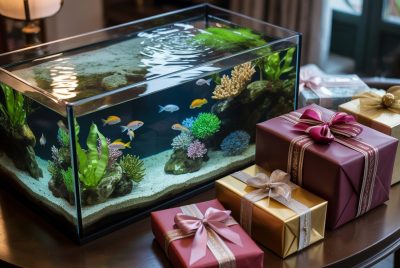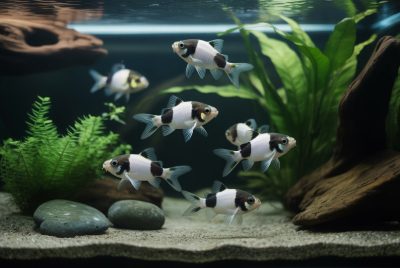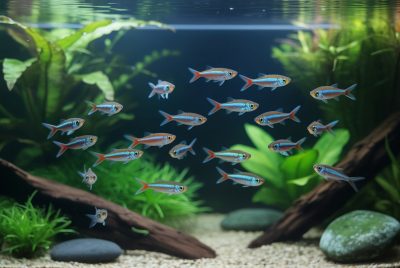IoT Integration in Home Aquariums: Complete Guide
*We may earn a commission for purchases made using our links. Please see our disclosure to learn more.
The gentle hum of water pumps mingles with the soft glow of LED lights as countless aquarium enthusiasts around the world discover the transformative power of IoT integration in home aquariums. What once required constant manual monitoring and guesswork has evolved into a sophisticated ecosystem where technology meets marine life, creating unprecedented levels of control and peace of mind for aquarium keepers.
Imagine checking your fish tank’s water parameters from across the globe, receiving instant alerts when something needs attention, or having your aquarium automatically adjust feeding schedules based on your fish’s behavior patterns. This isn’t science fiction—it’s the reality of modern smart aquarium systems that are revolutionizing how we care for aquatic pets.
“The integration of IoT technology in aquarium management represents a paradigm shift from reactive to proactive care, fundamentally changing how we interact with aquatic ecosystems in our homes.”
– Marine Technology Research Institute
Key Takeaways
- Automated Monitoring: IoT sensors continuously track water quality, temperature, and pH levels without manual intervention
- Remote Management: Control and monitor your aquarium from anywhere using smartphone apps and cloud connectivity
- Predictive Maintenance: Smart systems identify potential issues before they become critical problems
- Enhanced Fish Health: Consistent environmental conditions lead to healthier, more vibrant aquatic life
- Energy Efficiency: Automated lighting and heating systems optimize power consumption while maintaining ideal conditions
- Data-Driven Insights: Historical data helps optimize feeding schedules and environmental parameters
The Evolution of Aquarium Technology
The journey from traditional fishkeeping to smart aquarium management represents one of the most significant advances in the hobby’s history. Traditional aquarium maintenance required daily testing, manual adjustments, and constant vigilance to maintain optimal water conditions. The introduction of IoT sensors and connected devices has transformed this labor-intensive process into an elegant dance between technology and nature.
Smart aquarium systems integrate multiple components working in harmony: water quality sensors that monitor pH, ammonia, nitrite, and nitrate levels; temperature controllers that maintain precise thermal conditions; automated feeding systems that dispense food at optimal intervals; and lighting systems that simulate natural day-night cycles. These components communicate through wireless networks, creating a comprehensive monitoring and control ecosystem.
The transformation extends beyond mere convenience. IoT integration enables aquarium enthusiasts to maintain professional-grade water quality standards that were previously achievable only in commercial settings. This technological leap has opened new possibilities for keeping sensitive species that require precise environmental conditions, expanding the horizons of home aquarium keeping.
Essential IoT Components for Smart Aquariums
Water Quality Monitoring Systems
The foundation of any smart aquarium lies in comprehensive water quality monitoring. Modern IoT sensors continuously measure critical parameters including pH levels, dissolved oxygen, ammonia concentration, nitrite and nitrate levels, and total dissolved solids. These sensors typically connect to a central hub that processes data and triggers automated responses when parameters drift outside acceptable ranges.
Advanced monitoring systems feature calibration capabilities that ensure long-term accuracy, while cloud connectivity enables remote access to real-time data. Many systems include smartphone applications that display historical trends, helping aquarium keepers understand their tank’s unique patterns and optimize care routines accordingly.
Automated Feeding Solutions
Smart feeding systems represent a significant advancement in aquarium care, addressing one of the most common causes of fish health issues: overfeeding or irregular feeding schedules. IoT-enabled feeders can dispense precise portions at predetermined intervals, with many models offering multiple food compartments for varied diets.
These systems often include sensors that detect uneaten food, automatically adjusting portion sizes to prevent water quality degradation. Some advanced models incorporate cameras that monitor fish behavior during feeding times, providing insights into appetite changes that might indicate health issues or environmental stress.
Environmental Control Systems
Temperature regulation, lighting control, and water circulation form the trinity of environmental management in smart aquariums. IoT-connected heaters and chillers maintain precise temperature ranges, while smart lighting systems simulate natural sunlight patterns that support both fish health and plant growth in planted tanks.
Circulation pumps with IoT connectivity can adjust flow rates based on real-time conditions, creating optimal water movement patterns that prevent dead zones and ensure even distribution of nutrients and dissolved gases throughout the tank.
Overcoming Common IoT Integration Challenges
Network Connectivity and Reliability
One of the primary obstacles in implementing IoT systems is ensuring stable network connectivity. Aquarium environments, with their high humidity and electrical interference from pumps and filters, can challenge wireless signals. Successful implementations often require strategic placement of network extenders or mesh systems to maintain consistent connectivity.
Many aquarium keepers address this challenge by implementing redundant connectivity options, including both Wi-Fi and cellular connections, ensuring continuous monitoring even during network outages. Battery backup systems for critical sensors provide additional reliability during power interruptions.
Sensor Calibration and Maintenance
IoT sensors require regular calibration to maintain accuracy, and the aquatic environment can accelerate sensor degradation. Successful smart aquarium operators establish maintenance schedules that include sensor cleaning, calibration checks, and periodic replacement of consumable components.
Many modern systems include self-diagnostic capabilities that alert users when sensors require attention, while some advanced models feature automatic calibration routines that maintain accuracy with minimal user intervention.
Data Integration and Analysis
The wealth of data generated by IoT sensors can overwhelm newcomers to smart aquarium systems. Effective data management requires understanding which parameters are most critical for specific fish species and learning to interpret trends rather than focusing solely on instantaneous readings.
Successful implementations often begin with monitoring basic parameters before gradually expanding to more complex metrics. This approach allows aquarium keepers to develop proficiency with their systems while avoiding information overload.
The Comprehensive Smart Aquarium Ecosystem
Creating Seamless Integration
A truly smart aquarium requires thoughtful integration of multiple IoT components working in concert. The most successful installations begin with a robust central hub that can accommodate various sensors and controllers while providing reliable connectivity to mobile applications and cloud services.
Integration planning should consider future expansion possibilities, selecting systems that support additional sensors and controllers as the aquarium keeper’s expertise and requirements evolve. Modular systems often provide the best long-term value, allowing incremental upgrades without complete system replacement.
Customization for Specific Species
Different fish species have unique environmental requirements, and smart aquarium systems excel at maintaining these specific conditions. Saltwater reef tanks require precise salinity monitoring and calcium level management, while freshwater planted tanks need sophisticated CO2 regulation and nutrient monitoring.
Advanced IoT systems can store multiple profiles for different tank setups, automatically adjusting parameters when transitioning between species or during breeding programs. This flexibility makes it possible to maintain multiple tanks with varying requirements from a single control interface.
Predictive Analytics and Machine Learning
The most sophisticated smart aquarium systems incorporate machine learning algorithms that analyze historical data to predict potential issues before they become critical. These systems can identify subtle trends that indicate developing problems, such as gradual pH drift or changes in fish behavior patterns.
Predictive capabilities extend to maintenance scheduling, with systems learning the unique characteristics of each tank and automatically adjusting maintenance reminders based on actual conditions rather than generic schedules.
Transforming the Aquarium Keeping Experience
Enhanced Peace of Mind
IoT integration fundamentally changes the relationship between aquarium keepers and their aquatic pets. The constant worry about water quality, equipment failures, or feeding schedules diminishes significantly when smart systems provide continuous monitoring and automated responses to changing conditions.
Travel becomes less stressful when remote monitoring capabilities allow real-time checking of tank conditions from any location. Automated systems can maintain optimal conditions for extended periods, while alert systems ensure immediate notification of any issues requiring attention.
Educational Opportunities
Smart aquarium systems generate extensive data that provides unprecedented insights into aquatic ecosystem dynamics. This information helps aquarium keepers understand the complex relationships between feeding, waste production, bacterial colonies, and water chemistry.
Many enthusiasts find that IoT data transforms their understanding of aquarium biology, leading to improved care practices and more successful breeding programs. The ability to correlate environmental changes with fish behavior creates learning opportunities that were previously impossible to achieve.
Community and Sharing
Connected aquarium systems often include social features that enable sharing experiences with fellow enthusiasts. Data sharing capabilities allow comparison of different care approaches, while community forums provide platforms for discussing optimization strategies and troubleshooting challenges.
Some systems support data sharing with aquarium professionals, enabling remote consultation and expert advice based on actual tank conditions rather than general descriptions of problems.
Future Developments in Smart Aquarium Technology
Artificial Intelligence Integration
The next generation of smart aquarium systems will incorporate advanced AI capabilities that go beyond simple monitoring and control. These systems will learn individual tank characteristics and automatically optimize conditions for specific fish species and tank configurations.
AI-powered systems will eventually provide personalized recommendations for species selection, tank modifications, and care routines based on the keeper’s experience level and preferences. Machine learning algorithms will continuously refine these recommendations based on observed outcomes and community data sharing.
Advanced Sensor Technologies
Emerging sensor technologies promise even more comprehensive monitoring capabilities, including real-time analysis of water chemistry components that currently require manual testing. Optical sensors, spectroscopic analysis, and micro-fluidic testing systems will provide laboratory-quality analysis in home aquarium settings.
Biological sensors that monitor fish stress levels, activity patterns, and health indicators will provide unprecedented insights into aquatic pet welfare, enabling proactive health management that prevents disease rather than simply treating symptoms.
Integration with Smart Home Ecosystems
Future smart aquarium systems will integrate seamlessly with comprehensive smart home platforms, enabling coordination with other household systems. Lighting systems might coordinate with home lighting to create cohesive ambience, while HVAC systems could adjust room temperature based on aquarium heating requirements.
Voice control capabilities will enable hands-free operation of aquarium functions, while integration with home security systems could provide additional monitoring and alert capabilities during extended absences.
Practical Implementation Strategies
Starting Your Smart Aquarium Journey
Beginning IoT integration doesn’t require complete system replacement. Many aquarium keepers start with basic monitoring sensors that provide water quality data without automated control capabilities. This approach allows familiarization with smart systems while maintaining existing equipment.
Gradual expansion typically follows a logical progression: water quality monitoring, temperature control, lighting automation, and finally feeding systems. This staged approach spreads costs over time while allowing skill development at each phase.
Budget Considerations and ROI
Smart aquarium systems require initial investment that can seem substantial compared to traditional equipment. However, the long-term value proposition includes reduced fish mortality, lower maintenance costs, energy savings from optimized equipment operation, and the prevention of catastrophic system failures.
Many systems pay for themselves through reduced fish losses alone, while energy optimization features can significantly reduce electrical costs over time. The peace of mind and convenience factors provide additional value that’s difficult to quantify but highly appreciated by system users.
Professional Installation vs. DIY
The complexity of IoT integration varies significantly between systems, with some designed for easy DIY installation while others benefit from professional setup. Factors to consider include network infrastructure requirements, sensor placement optimization, and integration with existing equipment.
Many suppliers offer hybrid approaches with professional consultation during planning phases followed by guided DIY installation. This approach provides expert advice while maintaining cost control and enabling better understanding of system operation.
Maintaining Your Smart Aquarium System
Regular Maintenance Protocols
Even highly automated systems require regular maintenance to ensure optimal performance. Sensor cleaning, calibration verification, and software updates form the foundation of preventive maintenance programs. Most systems provide maintenance scheduling features that automate reminder notifications.
Battery replacement for wireless sensors, network connectivity testing, and backup system verification should be included in regular maintenance routines. These tasks, while minimal compared to traditional aquarium maintenance, are critical for system reliability.
Troubleshooting Common Issues
Smart aquarium systems can experience various technical issues, from connectivity problems to sensor malfunctions. Understanding basic troubleshooting procedures helps maintain system operation while professional support is arranged if needed.
Common issues include false alarms from dirty sensors, connectivity drops due to network interference, and calibration drift over time. Most systems include diagnostic features that help identify specific problems and guide resolution procedures.
System Updates and Upgrades
IoT systems benefit from regular software updates that improve functionality, add features, and address security concerns. Many systems provide automatic update capabilities, while others require manual intervention to install new software versions.
Hardware upgrades should be planned based on evolving needs and technological advances. The modular nature of most smart aquarium systems makes selective upgrades possible without complete system replacement.
Building a Supportive Community
Learning from Others
The smart aquarium community includes experienced professionals and enthusiastic hobbyists who share knowledge and experiences through online forums, social media groups, and local clubs. Engaging with this community provides valuable insights into system optimization and troubleshooting strategies.
Many manufacturers maintain user forums where customers share experiences, compare configurations, and provide mutual support. These resources often contain solutions to common problems and creative applications of system features.
Sharing Your Experience
As proficiency with smart aquarium systems develops, sharing experiences helps other aquarium keepers navigate their own IoT integration journeys. Contributing to community discussions, sharing data insights, and documenting successful configurations benefits the entire community.
Photography and video documentation of smart aquarium setups provide valuable references for others considering similar configurations. Social media platforms dedicated to aquarium keeping often feature smart system showcases that inspire and educate fellow enthusiasts.
Environmental Impact and Sustainability
Energy Efficiency Benefits
Smart aquarium systems typically reduce energy consumption through optimized equipment operation and intelligent scheduling. LED lighting systems with IoT control can adjust intensity and spectrum based on actual requirements rather than running at maximum output continuously.
Heating and cooling systems with smart controls maintain precise temperatures with minimal energy waste, while circulation pumps can adjust flow rates based on real-time conditions. These optimizations often result in significant energy savings compared to traditional constant-operation equipment.
Water Conservation
Automated water change systems can optimize water usage by monitoring actual water quality conditions rather than following fixed schedules. Smart systems change only the minimum water volume necessary to maintain optimal conditions, reducing both water consumption and waste production.
Leak detection capabilities prevent water waste from equipment failures, while automated top-off systems maintain water levels with minimal evaporation compensation. These features contribute to more sustainable aquarium operation.
Conclusion
The integration of IoT technology in home aquariums represents a fundamental shift in how we care for aquatic pets, transforming the traditional trial-and-error approach into a precise, data-driven science. Smart aquarium systems provide unprecedented control over water quality, environmental conditions, and feeding schedules while offering the peace of mind that comes with continuous monitoring and automated responses to changing conditions.
The journey toward smart aquarium keeping begins with understanding that technology should enhance rather than replace the fundamental joy of aquarium keeping. The most successful implementations combine sophisticated monitoring and control capabilities with the traditional aquarist’s appreciation for aquatic life and ecosystem dynamics.
As IoT technology continues to evolve, the possibilities for smart aquarium systems will expand, offering even more sophisticated monitoring capabilities, predictive analytics, and automated optimization features. The future promises systems that not only maintain optimal conditions but actively learn and adapt to create the perfect environment for each unique aquatic ecosystem.
For aquarium enthusiasts ready to embrace this technological evolution, the rewards extend far beyond convenience. Smart systems enable the successful keeping of sensitive species, provide educational insights into aquatic biology, and create opportunities for meaningful engagement with a global community of fellow aquarium keepers who share the passion for combining technology with the ancient art of fishkeeping.
The transformation from traditional to smart aquarium keeping is not just about adopting new technology—it’s about opening new possibilities for aquatic pet care that were previously unimaginable, creating better outcomes for both fish and their human caretakers while building a foundation for the future of home aquarium keeping.
Frequently Asked Questions
Q1: How much does a basic IoT aquarium monitoring system cost?
Basic IoT monitoring systems typically range from $200-500 for essential water quality sensors and smartphone connectivity. More comprehensive systems with automated controls can cost $800-2000, while professional-grade installations may exceed $3000. The investment often pays for itself through reduced fish mortality and energy savings.
Q2: Can I retrofit my existing aquarium with IoT technology?
Yes, most IoT aquarium systems are designed to work with existing equipment. You can start with basic monitoring sensors and gradually add automated controls. Retrofitting typically involves adding sensors to your current setup and connecting them to a central hub that communicates with your smartphone or computer.
Q3: What happens if my internet connection goes down?
Quality IoT aquarium systems include local backup capabilities that maintain critical functions during internet outages. Many systems store data locally and can operate automated functions independently of internet connectivity. Some systems also support cellular backup connections for continuous remote monitoring.
Q4: How accurate are IoT water quality sensors compared to traditional test kits?
Modern IoT sensors can be extremely accurate when properly calibrated, often matching or exceeding the precision of traditional test kits. Digital sensors provide continuous monitoring rather than periodic snapshots, offering better insight into water quality trends. However, sensors require regular calibration and maintenance to maintain accuracy.
Q5: Is IoT aquarium technology suitable for beginners?
While IoT systems add complexity, many are designed with user-friendly interfaces that can actually help beginners learn proper aquarium care. The continuous monitoring and automated alerts can prevent common mistakes that lead to fish health problems. Starting with basic monitoring systems allows beginners to learn gradually while benefiting from technological assistance.




